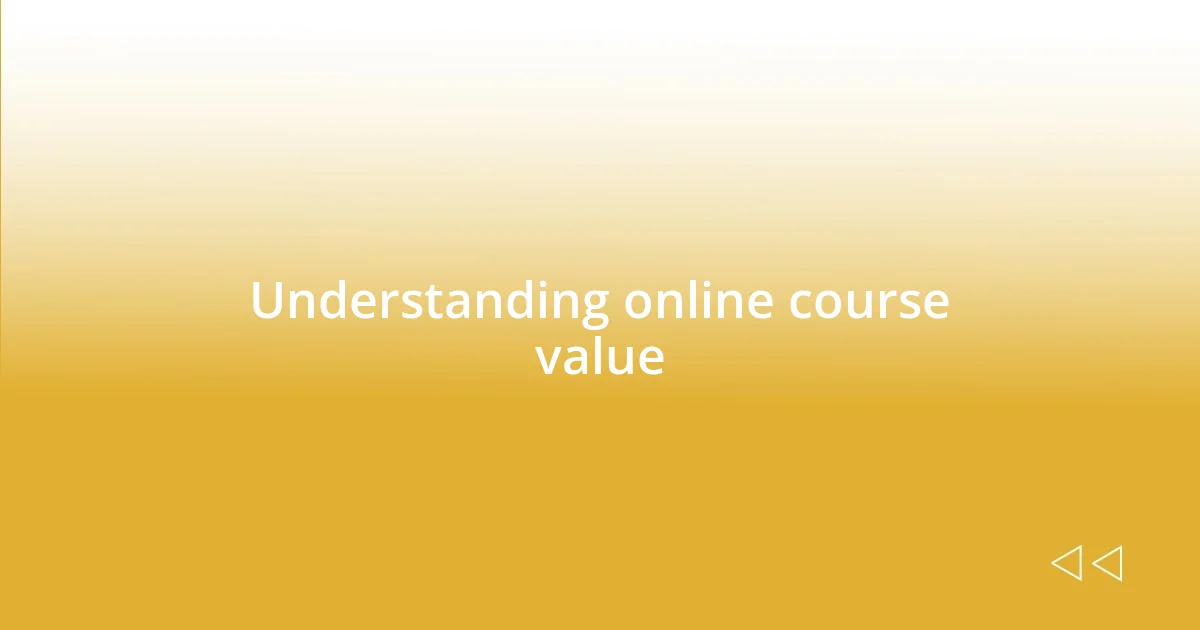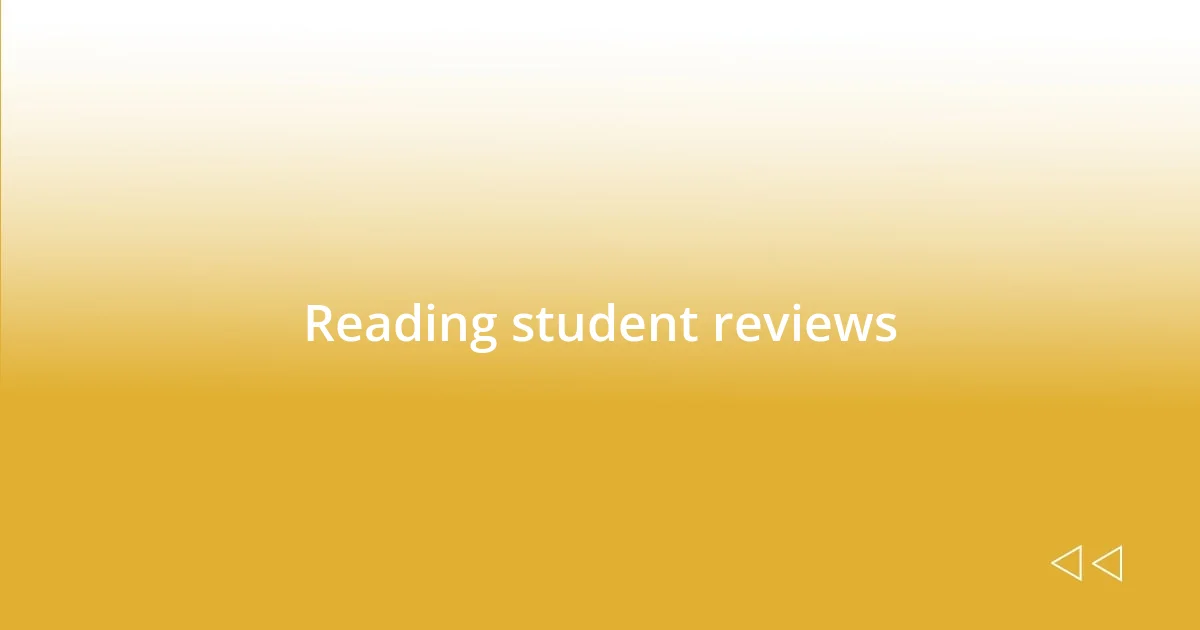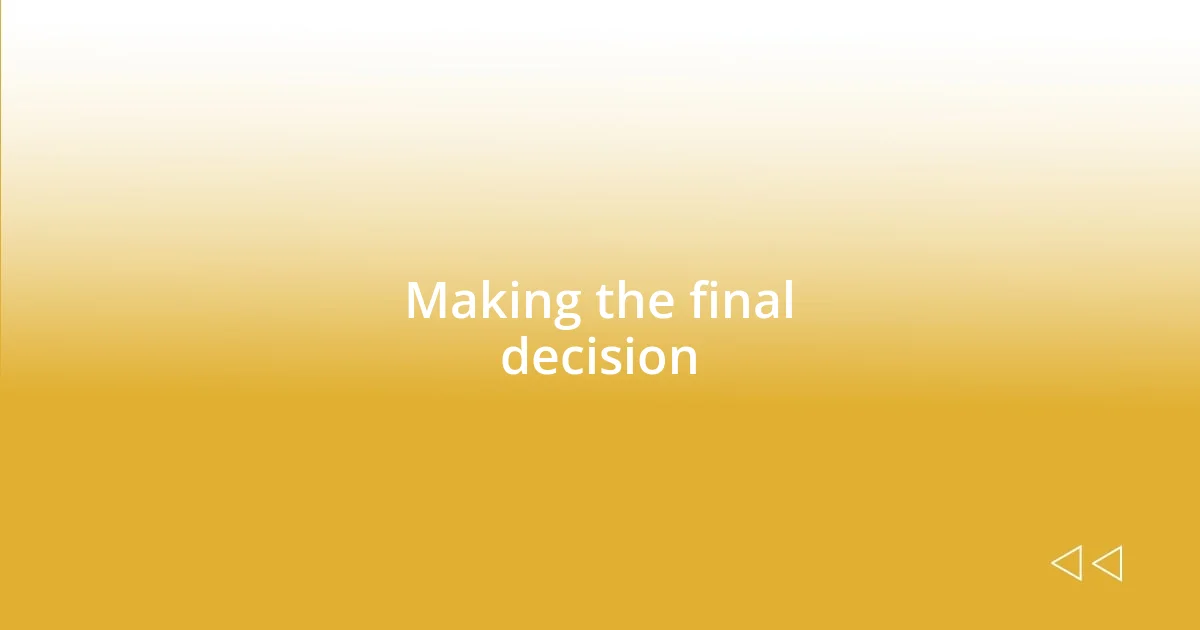Key takeaways:
- Evaluate the overall transformation and alignment with personal goals rather than just course content.
- Conduct thorough research on course providers, including instructor credentials and user reviews, to ensure a quality learning experience.
- Trust your instincts and emotional reactions when making the final decision on selecting a course to ensure motivation and engagement.

Understanding online course value
Understanding the value of an online course goes beyond just the content itself; it’s about the transformation you undergo as a learner. I remember enrolling in a graphic design course where initially, I felt overwhelmed. But as I progressed, not only did my skills improve, but my confidence soared, leading to freelance opportunities I couldn’t have imagined before.
When evaluating the worth of a course, consider factors like the instructor’s expertise and course reviews. Have you ever taken a course that promised the world but left you feeling like you’d just wasted time? I have, and it taught me to dig a little deeper into what others are saying. Personal testimonials can be a goldmine for understanding whether a course delivers meaningful results.
Lastly, think about how the course fits into your broader goals. Does it address your specific needs? I once took a course in digital marketing that completely changed my career trajectory. It isn’t just about knowledge acquisition; it’s about finding the right fit that aligns with your aspirations, and that’s where the real value lies.

Identifying your learning goals
Identifying your learning goals is a crucial step before diving into online courses. I’ve often found that clarity is key; when I sit down to define what I want to achieve, it sets the stage for a more rewarding learning experience. For instance, when I decided to learn coding, I realized I wanted not just to understand the basics but to build my own apps. This specificity guided my course selection significantly.
Another aspect I’ve learned over time is to prioritize my goals based on urgency and importance. I remember feeling torn between various subjects, but I finally settled on mastering data analysis because it directly related to my career aspirations. By ranking my learning objectives, I could focus on what offered the greatest value in the short term while aligning with my long-term vision.
Lastly, don’t forget to set measurable outcomes. For example, I aimed to complete two projects demonstrating my new skills after finishing a web development course. Tracking progress in this way not only kept me motivated but also allowed me to validate my learning effectively.
| Goal Type | Example |
|---|---|
| Skill Development | Learn a programming language to build apps |
| Career Advancement | Gain a certification in project management |
| Personal Enrichment | Explore creative writing for self-expression |

Researching course providers
Researching course providers is an essential step in ensuring I find the right online learning experience. By checking their credibility, I often uncover a wealth of insights. For example, when I was hunting for a photography course, I stumbled upon a platform that looked promising at first glance. However, after digging deeper, I discovered mixed reviews and questionable instructor credentials that made me pause. Trusting my instincts and verifying the information turned out to be vital.
To streamline my research, I focus on these specific factors:
- Accreditation: Is the provider recognized by educational authorities or industry leaders?
- Instructor qualifications: What experience do the instructors have in the field? Have they published work or led projects relevant to the course?
- User reviews: What are former students saying about their experiences? A few moments reading testimonials can save me from costly mistakes.
- Course delivery methods: Is the content engaging and interactive, or is it a series of dry lectures? I prefer a mix of video, practice exercises, and community discussions.
- Pricing structure: Is there transparency in pricing? I dislike hidden fees and appreciate when a course outlines all costs upfront.
I’ve found that being meticulous at this stage pays off significantly down the line, ensuring I choose a provider that aligns with my learning style and goals.

Evaluating course content quality
Evaluating course content quality is something I take seriously, as it can make or break my learning experience. When I was searching for a digital marketing course, I found myself reviewing the syllabus in detail. I remember feeling excited when I noticed how the course was structured—clear modules that covered both foundational concepts and advanced strategies. This gave me confidence that I could progressively build my understanding.
One thing I often ask myself is: does the course content resonate with real-world applications? For example, during my journey to learn graphic design, I stumbled upon a course that emphasized hands-on projects rather than just theory. Engaging tasks such as creating a portfolio piece or working on a mock client brief not only made learning enjoyable but also prepared me for actual challenges in the field. It was rewarding to apply what I learned and see the immediate outcomes of my efforts.
Lastly, I always look out for additional resources. While I once enrolled in a programming class that offered only video lectures, I quickly felt overwhelmed and underprepared. In contrast, I later discovered a course that provided supplementary reading materials, quizzes, and even access to a community forum for questions. This enriched experience meant I never felt isolated in my learning journey, as I had robust support to guide me along the way.

Checking instructor credentials
When I look into the credentials of an instructor, I can’t help but think about how critical it is to find someone who truly knows their stuff. For instance, I once enrolled in a coding course where the instructor boasted impressive titles. However, it wasn’t until I looked deeper that I learned they had little real-world experience. It made me wonder: what’s the point of learning from someone who hasn’t actually applied their knowledge outside of a classroom?
I also pay attention to the instructor’s engagement with the community. A great example that stands out for me was a graphic design course led by an industry veteran. Not only did they share their personal projects, but they also encouraged students to participate in discussions about real industry trends. This interaction made the learning feel dynamic and relevant. If the instructor isn’t invested in their students’ progress, how can I be sure I’m getting valuable insights?
Furthermore, I consider any published works the instructor might have. On one occasion, I found a course where the instructor had authored several articles in renowned design magazines. This background gave me confidence that they were genuinely knowledgeable and stayed updated with the latest trends. I often think: isn’t it reassuring to learn from someone who’s an active voice in their field? It’s those credentials that make all the difference when I’m looking for a course that truly enhances my skills.

Reading student reviews
Reading student reviews has become one of my go-to strategies for evaluating online courses. When I was considering a photography course, I found myself scouring reviews to get a sense of what previous students thought. The genuine praise mixed with constructive criticism often highlighted aspects I hadn’t considered, like the pace of the course or the accessibility of the materials. Engaging with these testimonials not only guided my decision but also made me feel connected to a community of learners who had walked that path before me.
A memorable moment came when I read a student’s account about a data science course that transformed their career trajectory. They described not just the content but the emotional journey of overcoming obstacles, which really resonated with me. It made me wonder: how often do we overlook the powerful personal impact a course can have? Real-life tales from students can illuminate the tangible outcomes—both professional and personal—that I would have otherwise missed.
I always keep an eye out for patterns in the reviews. If multiple students mention a lack of support or unclear explanations, it raises a red flag for me. Interestingly, I once read about a course where students praised a particular project as a game-changer, and that made me curious. Would their experience align with mine? Checking student reviews not only gives me insights, but it also feels like gaining a trusted opinion. It’s this shared experience that creates a sense of reassurance, guiding me toward the right choice for my learning journey.

Making the final decision
Making the final decision often comes down to trusting my instincts. After carefully considering all the factors—credentials, reviews, and course structure—I like to take a moment to envision what my learning experience will look like. I remember once, after a detailed comparison of multiple courses on digital marketing, I felt an inexplicable tug toward one particular option. It turned out to be the right choice as it transformed my understanding of the subject.
I find it helpful to visualize how this course will fit into my life. For instance, when I was weighing my options for an online writing course, I asked myself: will this blend with my current commitments? My previous experience taught me that a mismatch between course workload and my schedule can lead to frustration. So, I made sure the course would provide the flexibility I needed, and that little bit of foresight paid off tremendously in keeping me motivated.
In the end, I also pay attention to my emotional reaction to the course content. Does it excite me? When I explored a music production course, I felt that thrill of possibility just from reading the syllabus. That spark made it easy to decide, as I realized that genuine enthusiasm is often a sign of something that will keep me engaged. Isn’t it essential to choose a course that not only meets my professional goals but also ignites my passion?















